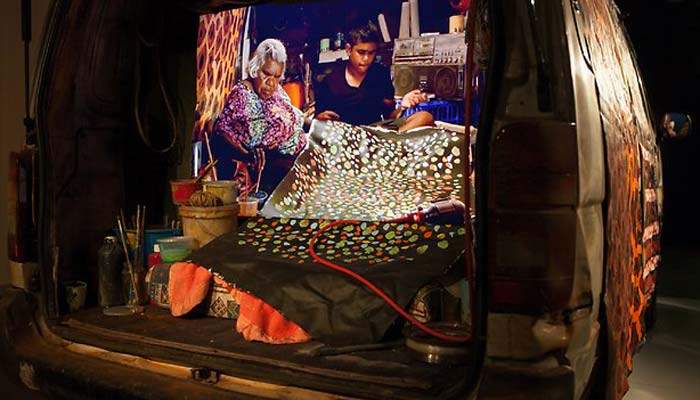Warwick Thornton: Mother Courage
Samson and Delilah director Warwick Thornton parks a dusty Toyota station wagon in ACMI for his latest installation.
Overview
Video art can be isolating, often presenting disjointed, non-linear images and sounds that lack obvious narrative or aesthetic meaning. The viewer, raised on a steady diet of numbing Hollywood blockbusters and sitcoms peppered with canned laughter designed to remind us how and when to feel, may balk. What is the story? Who are the characters? Where is the plot?
Although filmmaker and artist Warwick Thornton's recently parked (yes, parked) film installation at ACMI raises such questions, the immersive, inclusive nature of the piece ensures the audience is not lost to utter confusion. The viewer's introduction to Thornton's protagonists, Aboriginal matriarch Mother Courage (Grace Rubuntja), for whom the installation is named, and her grandson (Elijah Button) is informal — they have grown so accustomed to visitors circling the dusty Toyota campervan they call home that they probably won't even look up. Nanna is busy lovelessly churning out the Aboriginal dot paintings she sells to whitefellas to support herself and her grandson, who intermittently sips a can of Coke while listening to the local radio. Although it is logically apparent that the figures are merely projections, they are so vivid in their actions that one can almost smell the heady scent of paints, dust and sweat hanging in the air.
The van is caked in red earth and adorned with scribbles, trinkets, and paraphernalia that initially suggest your average frenetically decorated travelling wagon. On second glance a number of dual tensions emerge. Do the tiny Aboriginal figures on butcher's paper plastered to one side of the van resemble ants to suggest their homogeneity in the eyes of colonisers, or are they merely the innocent stick figures of a child? Is the red handprint smeared atop the hood a celebration of a tradition of hand painting, or a reminder of the gore of invasion? What of the newspaper article placed on the windshield that tells of “at risk youths” removed by the Department of Human Services?
A sense of uncertainty recurs as the audience struggles to place the resourceful Mother Courage character as either a victim or a hero. Forced out of the very homeland she now re-creates in conditions akin to a third world sweatshop, this poor old lady bears the strain of a grandchild one may uncomfortably assume has been forgotten by absent parents. On the flip side, she gets the last laugh; possibly charging thousands to guilt-riddled white, rich people who clear their colonial consciences by hanging dot paintings atop Victorian fireplaces, missing the irony.
It is interesting to note that Thornton, predominantly a director, has described his foray into the art world as “entertainment, but without financial gain”, in that it allows him an outlet not bound by the pressure and drawn out processes involved in the production of a film. In doing so he intrinsically links the validity of his own practice to the creative freedom it gives him, something that an artist limited to creating work that exists to feed a specific economic market, like Mother Courage, may never enjoy. Due to his economic, social and cultural position, Thornton has the flexibility to subvert traditional notions of what it means to be an Aboriginal working in a creative field. In Mother Courage, he does so by drawing attention to another Indigenous artist who is not in a position to do the same.
The point is not necessarily to find answers to the questions presented in Mother Courage surrounding the plight of Thornton's non-nuclear family and their real-life counterparts. Instead, all viewers need take away is that such conversations are worth having in the first place.





